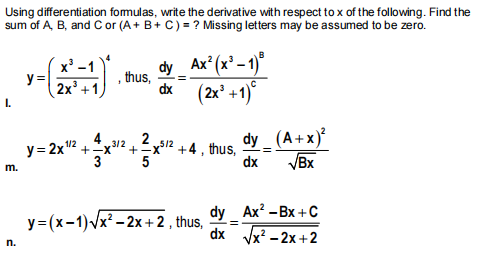Using differentiation fomulas, write the derivative with respect to x of the following. Find the sum of A B, and C or (A+ B+ C) = ? Missing letters may be assumed to be zero. x'. y = 2x + dy Ax* (x² – 1)* thus, dx (2x' +1)
Using differentiation fomulas, write the derivative with respect to x of the following. Find the sum of A B, and C or (A+ B+ C) = ? Missing letters may be assumed to be zero. x'. y = 2x + dy Ax* (x² – 1)* thus, dx (2x' +1)
Functions and Change: A Modeling Approach to College Algebra (MindTap Course List)
6th Edition
ISBN:9781337111348
Author:Bruce Crauder, Benny Evans, Alan Noell
Publisher:Bruce Crauder, Benny Evans, Alan Noell
Chapter1: Functions
Section1.2: Functions Given By Tables
Problem 32SBE: Does a Limiting Value Occur? A rocket ship is flying away from Earth at a constant velocity, and it...
Related questions
Question

Transcribed Image Text:Using differentiation fomulas, write the derivative with respect to x of the following. Find the
sum of A, B, and C or (A+ B+ C) = ? Missing letters may be assumed to be zero.
dy Ax* (x² – 1)°
thus,
y =
2x' +
dx (2x° +1)
dy (A+x)
VBx
4
3/2
+-x
2
y= 2x 2
+4, thus,
dx
+x512
3
5
m.
dy _Ax? -Bx + с
dx Vx? - 2x +2
у-(х-1) /x* - 2х + 2, thus,
n.
Expert Solution
This question has been solved!
Explore an expertly crafted, step-by-step solution for a thorough understanding of key concepts.
Step by step
Solved in 4 steps with 4 images

Recommended textbooks for you

Functions and Change: A Modeling Approach to Coll…
Algebra
ISBN:
9781337111348
Author:
Bruce Crauder, Benny Evans, Alan Noell
Publisher:
Cengage Learning

Functions and Change: A Modeling Approach to Coll…
Algebra
ISBN:
9781337111348
Author:
Bruce Crauder, Benny Evans, Alan Noell
Publisher:
Cengage Learning